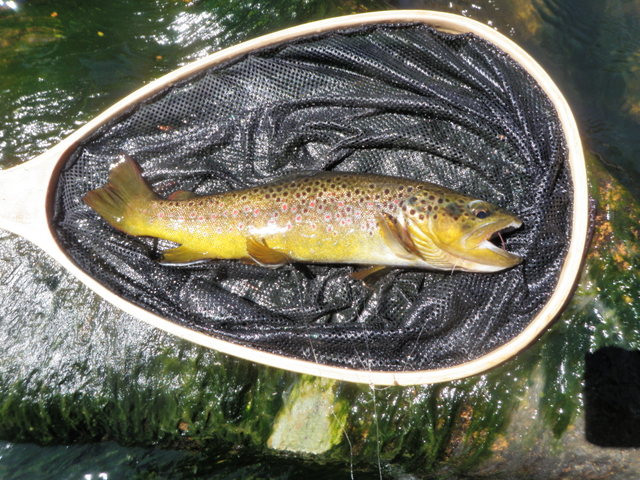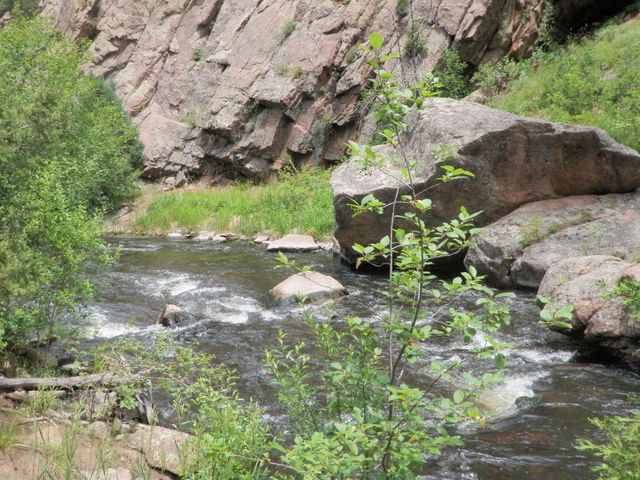Time: 9:30AM – 3:00PM
Location: Below Buttonrock Dam
Fish Landed: 36
North Fork of St. Vrain River 06/29/2013 Photo Album
Some days are just magical. Saturday June 29th turned out to be one of them.
As mentioned in the previous posting, I abandoned the Rincon Campground due to the high wind and inability to anchor my tent. In addition all the sites were reserved for Friday and Saturday night, so I needed to find a different location to camp, and I wasn’t sure where to look. The Arkansas River corridor is very popular at this time of the year due to the high river flows and the white water rafting crowd so I returned home to Denver on Friday night, but I didn’t give up on the idea of fishing on Saturday since Jane was scheduled to play tennis with her group that is getting ready for summer league play.
The question churning through my mind was where could I fish within a reasonable drive from Denver? I began my search by reviewing the Colorado DWS web site which logs stream flows. I checked South Boulder Creek below Gross Reservoir and the water was raging at close to 400 cfs. Clear Creek was rushing down the mountain at 500 cfs. Small Bear Creek was an option at 27 cfs, but it is very small, receives a fair amount of pressure and contains small fish. The Big Thompson below Lake Estes was clearly an option with steady flows at 128 cfs, and I’ve fished successfully at this level, but it is quite popular and frustrating to find space particularly on weekends. The South Platte at Deckers continues to run at very low levels with flows at 100 cfs at Deckers. This makes for difficult low clear water fishing and also can stress the fish. The North Fork of St. Vrain below Buttonrock Dam was listed at 93 cfs so this peaked my interest. 93 cfs, although high, is still a level that can be fished comfortably; however, another source listed the North Fork at 151 cfs.
I decided to make the NF of the St. Vrain River or Creek my destination and set out at 7:45. The drive was uneventful and I arrived at the gate parking area by 8:45 and quickly put on my waders, set up my Loomis five weight rod, and stuffed my water, raincoat and lunch in my backpack. I hiked the mile or so up the dirt road at a brisk pace as I targeted the stretch of water above the lower outlet pipe. I knew from previous experience that the water is released from the base of the dam, but additional water shoots into the stream from a narrow chute and culvert half a mile below the dam. I’m guessing the 93 cfs is the flow between the dam and the point where the second release enters. This proved to be a great strategy as the water above the pipe was much more manageable than below. I planned to fish to the dam, and then if time remained, retreat to a point where the road crossed the stream and try the stretch with more volume.
I recalled from previous years that the Chernobyl ant was productive on the St. Vrain and I liked the idea of a large buoyant foam attractor as my top fly. Beneath the Chernobyl I added a beadhead hares ear nymph and because the flows were fairly robust, I extended the leader to over three feet. At the tail of the large pool where I began, a twelve inch brown smashed the hares ear nymph and my fun day began. Another smaller brown smashed the Chernobyl ant at the top of the long deep pool and I was wondering if my good fortune was the product of the nice pool I began in, or would it continue in more marginal water?
I moved on and began drawing fish to the surface in all the likely places plus more marginal spots along the bank. That’s right, to the surface. Most of the fish were attacking the Chernobyl ant with conviction. Because I was wearing my polarized sunglasses I could see fish move at least two feet to inhale the large gaudy ant pattern. In addition it was thrilling to observe large swirls when browns crashed the low floating foam fly in the deep slots and seams along heavy current. These fish were also fairly nice sized browns by St. Vrain standards, and I landed quite a few chunky browns in the 13 and even 14 inch range.
The one downside was that many of the fish would create a massive tangle of the trailing line and dropper fly when they struck the top fly and then twisted and turned to escape the hook set. I debated removing the dropper several times, but each time I was about to pull the trigger, a fish would grab the hares ear, and I continued with the risk of tangle frustration. My fish count climbed into the twenties and I was having a blast prospecting my two flies in all the likely locations as I moved up along the right bank.
My focus was somewhat interrupted by the sound of thunder and the appearance of large gray clouds to the west, so I decided to find a pleasant spot on the bank and eat my lunch. I observed the water during my lunch break, but didn’t see any significant insect activity, so I resumed with the two flies that produced for me all morning. A short time after lunch the sky darkened even more, and I returned to the bank to put on my raincoat as a preemptive move. It was also at this time that I noticed some pale morning duns in the air. I never saw any on the water nor did I see any fish rise, but I decided to swap the hares ear for a pheasant tail in an effort to more closely imitate the pale morning dun nymph.
Amazingly this proved to be a great strategy and my catches over the remainder of the afternoon were split in a roughly 50/50 ratio between the Chernobyl ant and the beadhead pheasant tail. There were a few situations where I saw a fish rise almost the instant my flies hit the water and I assumed the Chernoyl ant was the target only to discover upon netting that the fish consumed the nymph. I’ve commented on this before, but I continue to be amazed by it.
In one instance I cast the flies to a place where a current angled from next to the bank back into a deeper area next to some main current. The angled run couldn’t have been more that two feet deep, but as I watched I saw a nice brown slide over from the bank position, move two feet and then grab the trailing pheasant tail. I love visual action such as this. Of course the exciting swirls and smashes of the Chernobyl ant continued in addition to the subsurface pheasant tail ambushes.
By three o’clock I reached the stretch of water below the settling pool of the dam and the wind blew a gentle mist toward me and also toward the east. Since it was already 3PM and I’d landed 36 fish I decided to call it quits and hike back down the road to my waiting Santa Fe.
What a day! I wasn’t sure I’d be able to fish the stream other than some small pockets along the edge, and I ended up landing 36 wild fish in a .5 mile stretch, and fly selection was about as easy as it gets. I’m assuming that the flows only recently dropped to the 93 cfs level and the fish are quite hungry after a month of high levels. Anything that looks like food is to their liking, and they aren’t spending a lot of time being particular. Even a flashy oversized Chernobyl ant looks like a tasty meal to these famished St. Vrain brown trout.




